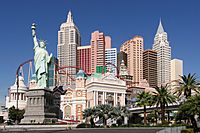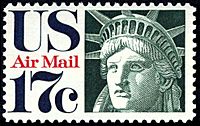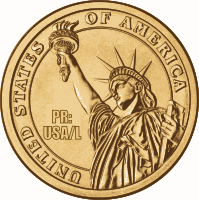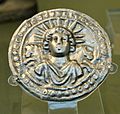Statue of Liberty facts for kids
Quick facts for kids
|
|
|---|---|
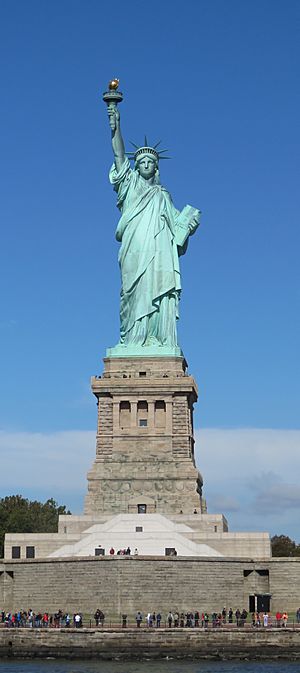 |
|
| Location | Liberty Island Manhattan, New York City, New York, U.S. |
| Height |
|
| Dedicated | October 28, 1886 |
| Restored | 1938, 1984–1986, 2011–2012 |
| Sculptor | Frédéric Auguste Bartholdi |
| Visitors | 3.2 million (in 2009) |
| Governing body | U.S. National Park Service |
| Website | Statue of Liberty National Monument |
| Type | Cultural |
| Criteria | i, vi |
| Designated | 1984 (8th session) |
| Reference no. | 307 |
| State Party | United States |
| Region | Europe and North America |
| Designated | October 15, 1924 |
| Designated by | President Calvin Coolidge |
| Official name: The Statue of Liberty Enlightening the World | |
| Designated | September 14, 2017 |
| Reference no. | 100000829 |
| Designated | May 27, 1971 |
| Reference no. | 1535 |
|
New York City Landmark
|
|
| Type | Individual |
| Designated | September 14, 1976 |
| Lua error in Module:Location_map at line 420: attempt to index field 'wikibase' (a nil value). | |
The Statue of Liberty, officially named Liberty Enlightening the World, is a monument symbolising the United States. The statue is placed near the entrance to New York City Harbor. The statue commemorates the signing of the United States Declaration of Independence.
The Statue of Liberty is one of the most recognizable symbols in the world. For many years it was one of the first glances of the United States for millions of immigrants and visitors after ocean voyages from around the world. ![]()
Contents
Construction
The statue was given to the United States by the people of France, to represent the friendship between the two countries established during the American Revolution.
Frédéric Auguste Bartholdi sculpted the statue and he obtained a U.S. patent for the structure. Maurice Koechlin, who was chief engineer of Gustave Eiffel's engineering company and designer of the Eiffel Tower, designed the internal structure. The pedestal was designed by the architect Richard Morris Hunt. Eugène Viollet-le-Duc chose copper in the construction of the statue, and for the adoption of the repoussé construction technique, where a malleable metal is hammered on the reverse side.
The statue is made of a covering of pure copper, left to weather to a natural blue-green patina. It has a framework of steel (originally puddled iron). The exception is the flame of the torch, which is coated in gold leaf (originally made of copper and later altered to hold glass panes). It is on a rectangular stonework pedestal with a foundation in the shape of an irregular eleven-pointed star.
Description
The statue represents a woman wearing a stola, a crown and sandals, trampling a broken chain, and with a torch in her raised right hand and a tabula ansata, where the date of the Declaration of Independence JULY IV MDCCLXXVI is written, in her left hand.
It is 151 ft (46 m) tall, but with the pedestal and foundation, it is 305 ft (93 m) tall.
Measurements
| Feature | Imperial | Metric |
|---|---|---|
| Height of copper statue | 151 ft 1 in | 46 m |
| Foundation of pedestal (ground level) to tip of torch | 305 ft 1 in | 93 m |
| Heel to top of head | 111 ft 1 in | 34 m |
| Height of hand | 16 ft 5 in | 5 m |
| Index finger | 8 ft 1 in | 2.44 m |
| Circumference at second joint | 3 ft 6 in | 1.07 m |
| Head from chin to cranium | 17 ft 3 in | 5.26 m |
| Head thickness from ear to ear | 10 ft 0 in | 3.05 m |
| Distance across the eye | 2 ft 6 in | 0.76 m |
| Length of nose | 4 ft 6 in | 1.48 m |
| Right arm length | 42 ft 0 in | 12.8 m |
| Right arm greatest thickness | 12 ft 0 in | 3.66 m |
| Thickness of waist | 35 ft 0 in | 10.67 m |
| Width of mouth | 3 ft 0 in | 0.91 m |
| Tablet, length | 23 ft 7 in | 7.19 m |
| Tablet, width | 13 ft 7 in | 4.14 m |
| Tablet, thickness | 2 ft 0 in | 0.61 m |
| Height of pedestal | 89 ft 0 in | 27.13 m |
| Height of foundation | 65 ft 0 in | 19.81 m |
| Weight of copper used in statue | 60,000 pounds | 27.22 tonnes |
| Weight of steel used in statue | 250,000 pounds | 113.4 tonnes |
| Total weight of statue | 450,000 pounds | 204.1 tonnes |
| Thickness of copper sheeting | 3/32 of an inch | 2.4 mm |
Location
The statue is on Liberty Island in New York Harbor, and it welcomes visitors, immigrants, and returning Americans traveling by ship.
The statue is the central part of the Statue of Liberty National Monument, administered by the National Park Service. The National Monument also includes Ellis Island.
Inscriptions, plaques, and dedications
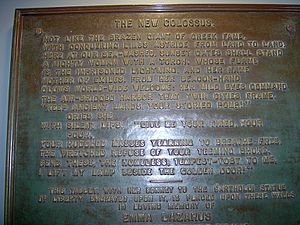
There are several metal plaques on or near the Statue of Liberty. A plaque on the copper just under the figure's feet declares that it is a colossal statue representing Liberty, designed by Bartholdi and built by the Paris firm of Gaget, Gauthier et Cie (Cie is the French abbreviation analogous to Co.). Another plaque declares the statue to be a gift from the people of the Republic of France that honors "the Alliance of the two Nations in achieving the Independence of the United States of America and attests their abiding friendship." The New York committee made a plaque that commemorates the fundraising done to build the pedestal. The Freemasons put another plaque on the cornerstone.
In 1903, a bronze tablet that bears the text of "The New Colossus" and commemorates Emma Lazarus was presented by friends of the poet. Until the 1986 renovation, it was mounted inside the pedestal; today it resides in the Statue of Liberty Museum in the base. It is accompanied by a tablet given by the Emma Lazarus Commemorative Committee in 1977, celebrating the poet's life.
A group of five statues is at the western end of the island. They honor people involved in building the Statue of Liberty. The statues stand for two Americans—Pulitzer and Lazarus—and three Frenchmen—Bartholdi, Laboulaye, and Eiffel. The five statues were designed by Maryland sculptor Phillip Ratner.
In 1984, the Statue of Liberty was designated a UNESCO World Heritage Site. The UNESCO "Statement of Significance" describes the statue as a "masterpiece of the human spirit" that "endures as a highly potent symbol—inspiring contemplation, debate and protest—of ideals such as liberty, peace, human rights, abolition of slavery, democracy and opportunity."
Historical designations
President Calvin Coolidge officially designated the Statue of Liberty as part of the Statue of Liberty National Monument in 1924. The monument was expanded to also include Ellis Island in 1965. The following year, the Statue of Liberty and Ellis Island were jointly added to the National Register of Historic Places, and the statue individually in 2017. On the sub-national level, the Statue of Liberty National Monument was added to the New Jersey Register of Historic Places in 1971, and was made a New York City designated landmark in 1976.
In 1984, the Statue of Liberty was designated a UNESCO World Heritage Site. The UNESCO "Statement of Significance" describes the statue as a "masterpiece of the human spirit" that "endures as a highly potent symbol—inspiring contemplation, debate and protest—of ideals such as liberty, peace, human rights, abolition of slavery, democracy and opportunity."
Depictions
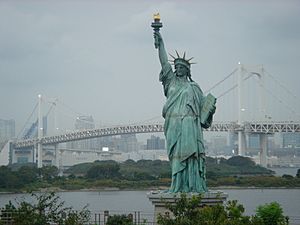
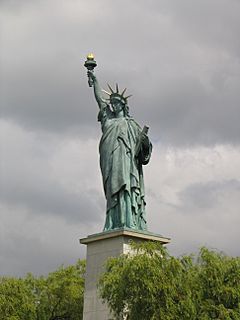
Hundreds of replicas of the Statue of Liberty are displayed worldwide. A smaller version of the statue, one-fourth the height of the original, was given by the American community in Paris to that city. It now stands on the Île aux Cygnes, facing west toward her larger sister. A replica 30 feet (9.1 m) tall stood atop the Liberty Warehouse on West 64th Street in Manhattan for many years; it now resides at the Brooklyn Museum. In a patriotic tribute, the Boy Scouts of America, as part of their Strengthen the Arm of Liberty campaign in 1949–1952, donated about two hundred replicas of the statue, made of stamped copper and 100 inches (2.5 m) in height, to states and municipalities across the United States. Though not a true replica, the statue known as the Goddess of Democracy temporarily erected during the Tiananmen Square protests of 1989 was similarly inspired by French democratic traditions—the sculptors took care to avoid a direct imitation of the Statue of Liberty. Among other recreations of New York City structures, a replica of the statue is part of the exterior of the New York-New York Hotel and Casino in Las Vegas.
As an American icon, the Statue of Liberty has been depicted on the country's coinage and stamps. It appeared on commemorative coins issued to mark its 1986 centennial, and on New York's 2001 entry in the state quarters series. An image of the statue was chosen for the American Eagle platinum bullion coins in 1997, and it was placed on the reverse, or tails, side of the Presidential Dollar series of circulating coins. Two images of the statue's torch appear on the current ten-dollar bill. The statue's intended photographic depiction on a 2010 forever stamp proved instead to be of the replica at the Las Vegas casino.
Depictions of the statue have been used by many regional institutions. Between 1986 and 2000, New York State issued license plates with an outline of the statue. The Women's National Basketball Association's New York Liberty use both the statue's name and its image in their logo, in which the torch's flame doubles as a basketball. The New York Rangers of the National Hockey League depicted the statue's head on their third jersey, beginning in 1997. The National Collegiate Athletic Association's 1996 Men's Basketball Final Four, played at New Jersey's Meadowlands Sports Complex, featured the statue in its logo. The Libertarian Party of the United States uses the statue in its emblem.
The statue is a frequent subject in popular culture. In music, it has been evoked to indicate support for American policies, as in Toby Keith's 2002 song "Courtesy of the Red, White and Blue (The Angry American)", and in opposition, appearing on the cover of the Dead Kennedys' album Bedtime for Democracy, which protested the Reagan administration. In film, the torch is the setting for the climax of director Alfred Hitchcock's 1942 movie Saboteur. The statue makes one of its most famous cinematic appearances in the 1968 picture Planet of the Apes, in which it is seen half-buried in sand. It is knocked over in the science-fiction film Independence Day and in Cloverfield the head is ripped off. In Jack Finney's 1970 time-travel novel Time and Again, the right arm of the statue, on display in the early 1880s in Madison Square Park, plays a crucial role. Robert Holdstock, consulting editor of The Encyclopedia of Science Fiction, wondered in 1979:
Where would science fiction be without the Statue of Liberty? For decades it has towered or crumbled above the wastelands of deserted Earth—giants have uprooted it, aliens have found it curious ... the symbol of Liberty, of optimism, has become a symbol of science fiction's pessimistic view of the future.
-
A replica of the Statue of Liberty forms part of the exterior decor at the New York-New York Hotel and Casino on the Las Vegas Strip
-
Reverse side of a Presidential Dollar coin
Images for kids
-
The Roman goddess Libertas and Sol Invictus ("The Unconquered Sun") (shown here) both influenced the Statue of Liberty.
-
Detail from a 1855–56 fresco by Constantino Brumidi in the Capitol in Washington, D.C., showing two early symbols of America: Columbia (left) and the Indian princess
-
Thomas Crawford's Statue of Freedom (1854–1857) tops the dome of the Capitol building in Washington
-
Stereoscopic image of right arm and torch of the Statue of Liberty, 1876 Centennial Exposition
-
Frank Leslie's Illustrated Newspaper, June 1885, showing (clockwise from left) woodcuts of the completed statue in Paris, Bartholdi, and the statue's interior structure
-
Unveiling of the Statue of Liberty Enlightening the World (1886) by Edward Moran. Oil on canvas. The J. Clarence Davies Collection, Museum of the City of New York.
-
Bedloe's Island in 1927, showing the statue and army buildings. The eleven-pointed walls of Fort Wood, which still form the statue's base, are visible.
-
July 4, 1986: First Lady Nancy Reagan (in red) reopens the statue to the public.
-
The Statue of Liberty on September 11, 2001 as the Twin Towers of the World Trade Center burn in the background
-
The Statue of Liberty's original torch (1886–1984) displayed in the Statue of Liberty Museum on Liberty Island
-
Tourists aboard a Circle Line ferry arriving at Liberty Island, June 1973
-
The Statue of Liberty stands on Liberty Island
-
Replica on Odaiba in Tokyo Bay, Japan, near the Rainbow Bridge
-
Statue of Liberty from Pont de Grenelle, Paris
See also
 In Spanish: Estatua de la Libertad para niños
In Spanish: Estatua de la Libertad para niños


